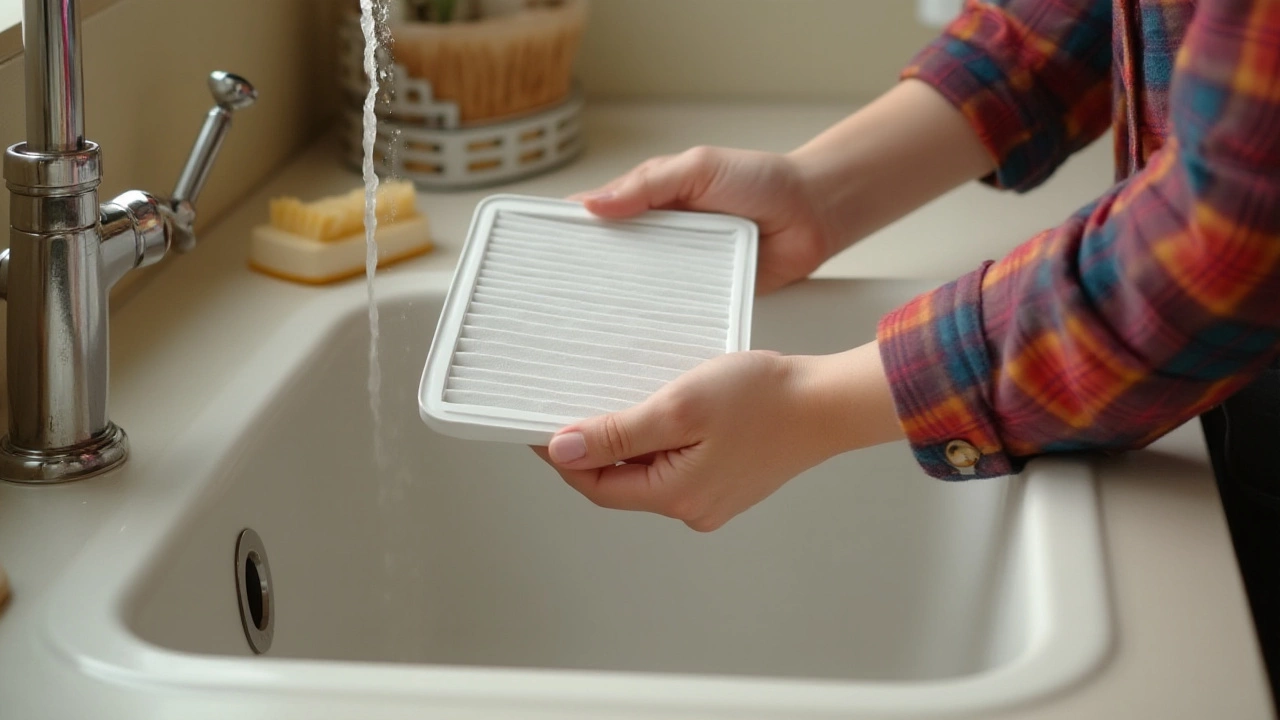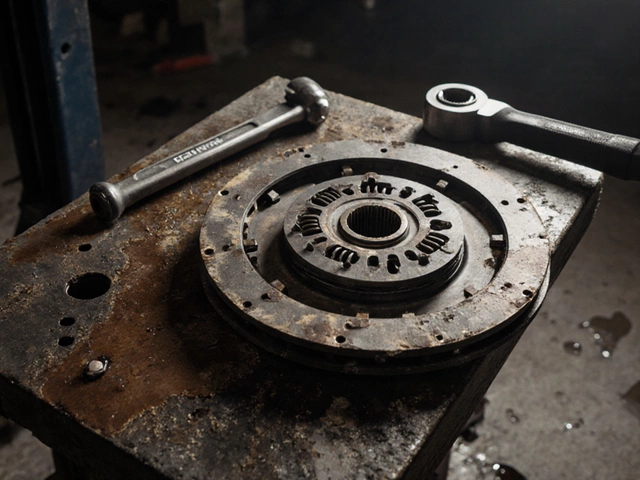Breathing clean air in our homes often depends on the humble air filter, a device that quietly ensures our environment stays fresh and free from unwanted particles. Yet, the question on many minds is whether they should clean or replace their air filters. Understanding the different types of filters can make this decision easier.
There are washable filters designed specifically for reuse, which can save both money and reduce waste. While some see cleaning as a hassle, the benefits of properly maintaining these filters go beyond simply extending their life. They actually contribute to a healthier home environment.
This article dives into the practicalities of cleaning your air filter, including recognizing when it's time for maintenance and when it's time to shop for a new one. With easy-to-follow tips and expert advice, you'll soon be able to ensure that the air in your house is of the highest quality.
- Understanding Air Filter Types
- Signs Your Filter Needs Attention
- How to Clean a Washable Air Filter
- Benefits of Regular Maintenance
- When to Replace Instead of Clean
- Tips for Maintaining Indoor Air Quality
Understanding Air Filter Types
When it comes to maintaining a healthy home environment, recognizing the different types of air filters that are available can make a significant difference. The air filter you choose is crucial in protecting both your health and your HVAC system. Various filters serve different purposes, ranging from basic dust capture to highly sophisticated systems designed to neutralize allergens and pollutants. The most commonly encountered filters include fiberglass, pleated, electrostatic, and high-efficiency particulate air (HEPA) filters. Once you learn about their specific features and applications, you'll be able to make a more informed choice regarding cleaning or replacing them.
Fiberglass air filters are generally considered the most affordable option, both in price and function. They are composed of a simple mesh of fiber that traps large particles like dust and lint. They are primarily designed to protect your HVAC system from debris rather than improving indoor air quality. While fiberglass filters are cost-effective, they don't capture smaller particles like pollen or mold. Typically, these should be replaced every month or two, and cleaning them isn't typically recommended as their structure doesn't allow for it.
Pleated filters offer the next level of protection. Made from polyester or cotton paper, these filters are pleated to increase their surface area, allowing them to catch more particles than fiberglass. Their enhanced design helps trap dust mites, pet dander, and pollen, making them suitable for those looking to improve air quality. Pleated filters last longer than their fiberglass counterparts—up to 90 days—but cleaning can sometimes rejuvenate them, depending on the manufacturer's advice.
Then, there are electrostatic filters, which work by using static electricity to attract and hold particles. Some electrostatic filters are washable and reusable, which makes maintaining them simple and cost-effective in the long run. These filters are a great choice for families with allergies, as they are efficient at catching small irritants that could cause adverse reactions. However, it's vital to ensure they are cleaned correctly, following proper processes to maintain their efficiency.
Finally, we arrive at HEPA filters, typically seen as the gold standard for air filtration. These filters can capture at least 99.97% of particles with a diameter of 0.3 microns or larger, making them incredibly effective against things like bacteria and smoke, aside from common allergens. Due to their design and purpose, HEPA filters cannot be washed. Attempting to clean them not only diminishes their effectiveness but can also damage the filter itself. It's important to replace HEPA filters as per the manufacturer's guidance to ensure optimal air quality.
"The efficiency of air filters has improved dramatically, and choosing the right type depends on what indoor air quality issues you most want to address," notes an industry expert from the Indoor Air Quality Association.
To sum up the key differences in air filter types, and their maintenance requirements, consider the facts below:
- Fiberglass filters: Cost-effective, disposable, traps large particles, monthly replacement.
- Pleated filters: Mid-range price and efficiency, some reusable options, good for allergens, quarterly swap needed.
- Electrostatic filters: Reusable, ideal for families with allergies, maintain through regular washing.
- HEPA filters: High efficiency, non-washable, must be replaced according to guidelines, perfect for smoke and bacteria removal.
Now, with a clearer comprehension of filter types, maintaining your home’s air quality becomes less of a guessing game and more a scientific approach. Taking into account your specific needs alongside expert recommendations will yield cleaner air and a healthier living environment.
Signs Your Filter Needs Attention
Detecting the signs that your home's air filter requires care is crucial for maintaining a clean and safe living space. If you've noticed a considerable decrease in air circulation within your home, it might point to an air filter that needs cleaning or replacing. Understandably, people often overlook these devices until dust levels become noticeable, or the airflow is disturbed. The task here is to recognize subtle cues that might go unnoticed until discomfort becomes more apparent. For instance, if you're experiencing unexplained spikes in utility bills, it could be due to the HVAC system working harder to compensate for restricted airflow, a classic symptom of a clogged filter. If you see or smell dust shortly after cleaning, your filters might not be doing their jobs properly, allowing unwanted particles to circulate.
When allergies seem to spike, especially when you're indoors, your home maintenance routine might be due for an update. An air filter that's choked with grime and pollutants can lead to inefficient air purification, acting as a red flag for those suffering from allergies or respiratory issues. You could also perform a simple light test. Hold the filter up to a light source; if light doesn’t pass through, it’s likely time for a change or a thorough clean. To add, strange odors that linger longer than usual, particularly mustiness, could be hinting at mold growth, suggesting immediate attention.
Visiting your local home improvement store invariably leads you past shelves filled with air filter options, none of which include a 'replace by' sign. Without obvious indicators, knowing when to pay attention becomes the homeowner’s sleuthing duty. For sophisticated advice, we glean some wisdom from industry experts. In an insightful piece published by the National Air Filter Association, specialists emphasize the need to inspect air filters every month. To quote,
"Most homeowners don’t realize the importance of inspecting air filters regularly until air quality issues arise, but consistent check-ups can prevent many problems before they begin."
There's also a seasonal aspect to be mindful of. During the high pollen months such as spring, or heavy smog periods depending on your area, your filter could be working overtimes, making frequent checks a wise practice. For those with pets, it becomes even more imperative. Pet hair and dander can clog filters faster than typical household dust. Observing your air filter once a month, noting changes in color, texture, and effectiveness, ultimately supports your household in sustaining clean air.
How to Clean a Washable Air Filter
Clean air is priceless when it comes to our health and comfort at home. A clean air filter plays a vital role in ensuring your living environment remains pristine. If you're using a washable filter, that's good news for both your wallet and the planet. Yet, the process demands a touch of care and attention.
First, it's crucial to disconnect the air filter from its housing gently. Before you begin, make sure to turn off your system completely. This action prevents any dust release into your home and early wear on your HVAC system. Next, observe the filter for visible dust and dirt build-up. A hefty layer of grime is the primary clue that it's cleaning time.
Once removed, rinse off the filter from both sides using a gentle flow of water. A high-pressure spray may damage the fine mesh, so it’s best avoided. Allow gravity to guide the dust and dirt away with minimal scrubbing. With that done, mix a mild detergent with warm water to soak the filter. Letting it soak can break down any stubborn particles clinging to the filter over time. This simple method is effective in extending the performance lifespan of your filter as well as the air quality of your home.
After soaking, give the filter one final rinse to wash away any remaining soap. It's crucial to dry the filter thoroughly before placing it back to avoid mold growth. Allow it to drip-dry naturally in a well-ventilated space, steering clear of direct sunlight. Patience pays off here, as placing the damp filter back too soon can lead to less-than-ideal surprises like a soggy filter collapsing under pressure.
When you're happy, place it back securely. Your system is now set to run with a cleaner, more efficient air filter. You'll likely notice a difference in the airflow immediately. Besides maintaining indoor comfort, this also helps the entire HVAC system operate within its optimal capacity, possibly saving on future costly repairs or replacements.
"A clean filter is a happy filter," remarks John McLellan, an HVAC expert with over two decades of experience. "It's one of the simplest things you can do to maintain air quality and system efficiency."
It's recommended to mark your calendar for monthly checks. Despite claims that cleaning lasts up to six months, variations in air quality or system use may require more frequent attention to your clean air filter. For conclusive results, it's always wise to rely on direct observation over manufacturer claims.

Benefits of Regular Maintenance
Regular maintenance of your home air filters offers a multitude of advantages that go beyond simple functionality. One of the most significant benefits of consistent upkeep is the enhancement of your indoor air quality. By ensuring your air filter is either cleaned or replaced routinely, you're effectively reducing the concentration of pollutants, allergens, and dust particles in your home. This action lowers the risk of respiratory issues and allergies, especially in young children and elderly adults who could be more vulnerable to pollutants. A clean filter can capture a higher percentage of particles leading to a comprehensive improvement in air quality.
Another compelling advantage of maintaining your air filter is the potential cost savings it generates. While an initial investment may be required for high-quality, reusable filters, the savings over time are evident. Cleaning reusable filters regularly can mean spending considerably less on disposables. Moreover, regular maintenance can prolong the lifespan of your HVAC system. By keeping the system free of debris and enabling it to operate efficiently, you're preventing wear and tear, which could lead to costly repairs or replacements.
"Regular maintenance is key to maximizing the efficiency and lifespan of your home's heating and air conditioning equipment," notes James Turner, an HVAC expert. "It's a simple task that can save homeowners a lot of money in the long run."
Energy efficiency is another primary benefit of keeping up with filter maintenance. A clogged or dirty filter forces your HVAC system to work harder, using more energy to circulate air. This can cause a noticeable increase in your utility bills. Cleaning or replacing filters ensures that your system is running optimally, reducing your home's energy consumption—a significant boon for both your wallet and the environment. Alongside these practical benefits, regular filter maintenance fosters peace of mind, knowing that the invisible allies in your home are working efficiently to keep your air clean and healthy.
Additional Benefits for Allergy Sufferers
For those who suffer from allergies or asthma, clean air filters can be a game-changer. They help to remove pollen, pet dander, and even mold spores from the air you breathe. This can lead to a marked reduction in symptoms, enabling individuals to breathe easier and live more comfortably within their own homes. Furthermore, consistent air filter maintenance can be especially beneficial in households with pets. Pet hair and dander are notorious for blocking filters, which can quickly reduce land air quality. Regular cleaning or replacement ensures these allergens don't linger in the air, making for a more pleasant living environment for everyone.People involved in maintenance often find themselves thinking about sustainability. By opting to clean rather than constantly replace filters, you're reducing your household's waste and lowering your carbon footprint. This contributes to greater environmental consciousness and can even inspire others around you to consider more sustainable practices. There's an undeniable sense of responsibility and satisfaction that comes with regular maintenance. It's a straightforward task that, while often overlooked, can significantly impact your home's air quality and your overall quality of life.
When to Replace Instead of Clean
Knowing when it's time to replace your air filter rather than clean it is crucial for maintaining efficient performance and optimum air quality. There are several indicators that your filter has reached the end of its life. Primarily, if you continue to experience poor air quality despite routine cleaning, it might be a signal that the air filter is no longer doing its job. This can happen because, over time, certain particles can embed themselves so thoroughly within the filter material that no amount of cleaning will dislodge them, leading to reduced airflow and efficiency.
In addition to air quality issues, visual inspections can be revealing. Many filters are made from materials that degrade over time, especially those filters that require frequent dampening or washing. For instance, if there are visible tears or noticeable thinning of the filter material, replacement is not just a suggestion but a necessity. Prolonged exposure to pollutants and moisture can weaken the integrity of the filter media, making it unable to capture particles effectively. In any home maintenance activity like air filter cleaning, the key is to observe the wear and tear closely and act accordingly.
According to a report from the American Society of Heating, Refrigerating and Air-Conditioning Engineers, 'Regular replacement of air filters as per the manufacturer's recommendation can increase HVAC efficiency by 5-15%.'
Sometimes, the decision to replace rather than clean comes down to time efficiency. Not all filters are created equal, and some might take longer to clean thoroughly. When time is of the essence and the air filter appears heavily clogged, it often makes more sense to opt for replacement. Also, consider the lifecycle recommended by the manufacturer. If it’s nearing the filter's end-of-life despite still being operational, it’s wise to schedule a replacement to avoid any unexpected system failures.
A particularly compelling reason to replace comes in special circumstances, such as after a renovation or if someone in the household has severe allergies. Construction debris and allergens like pollen can be so minuscule and prone to entrenching deeply within the filter's fibers, rendering cleaning efforts futile. Investing in a new filter at these times contributes significantly to maintaining a healthy and allergen-free home environment.
| Filter Type | Average Lifespan | Replacement Indicator |
|---|---|---|
| Fiberglass Filters | 30 days | Clogged or torn |
| HEPA Filters | 6-12 months | Persistent odor or poor airflow |
| Pleated Filters | 3 months | Deformation or damage |
Ultimately, the choice to replace an air filter rather than clean contributes directly to maintaining cost-effectiveness in the long run. While cleaning reusable filters can save money, ignoring the signs that a filter is beyond its prime may lead to higher energy bills and costly repairs to your HVAC system as it struggles to function efficiently. By paying attention to these critical signs, you ensure a clean air environment without unnecessary interruptions or expenses.
Tips for Maintaining Indoor Air Quality
Living in a clean environment isn't just about appearance, but also about the air we breathe within our homes. Regular air filter cleaning is vital, but maintaining indoor air quality involves a variety of steps that can help ensure your living space remains healthy. An essential starting point is to establish a cleaning routine that focuses not only on visible surfaces but also targets often-overlooked areas like vents and ducts, which can become a repository for dust and allergens.
An appreciated approach is to bring in the outdoors, utilizing houseplants known for their air-purifying qualities. Plants such as the snake plant, spider plant, and peace lily not only add aesthetic value to a room but also help filter out various pollutants, improving oxygen levels. It’s like having a mini ecosystem work within your walls, maintaining purity while requiring minimal care.
Ventilation also plays a crucial role in securing high indoor air quality. This doesn't mean flinging open windows in the dead of winter; rather, it involves ensuring that fans and ventilation systems are functioning properly and regularly inspected. Using an exhaust fan while cooking or a bathroom fan during a steamy shower can keep excess moisture and unwanted particles at bay, combating mold growth and lingering odors.
The choice of cleaning products can also make a significant difference. Traditional cleaning chemicals might inadvertently contribute to poor air quality, releasing volatile organic compounds (VOCs) into the air. Opting for natural, eco-friendly cleaning products can minimize this risk. Look for labels that specify low-VOC content. This seemingly small change can establish a safer environment for everyone at home, particularly for those with sensitive respiratory systems.
According to a report by the Environmental Protection Agency, “Indoor pollution levels can be 2 to 5 times higher than outdoor levels, and occasionally more than 100 times higher.”Recognizing this, it becomes clear how improving indoor air standards is essential. An air purifier can work wonders in removing smaller particles and giving an overall fresher feel like nature's own blend of freshness.
For those looking to document changes and improvements, utilizing an air quality monitor provides tangible evidence of efforts. Being able to visually see particle counts, humidity, and temperature readings can motivate further action and pinpoint what needs more attention. It’s also an engaging project for tech enthusiasts, as many modern monitors connect seamlessly to smartphone apps, offering alert systems or weekly reports.
Incorporating these tasks into a regular schedule not just improves the health and well-being of your household but can also increase the lifespan of home appliances. A clean home, bolstered by regular filter replacement or cleaning when necessary, results in efficient systems that don’t have to work overtime to maintain comfort.






